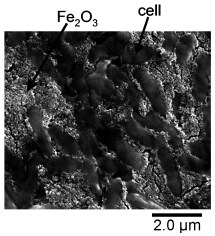New insights into the workings of a metal-munching bacteria and how it exploits semiconducting nanominerals could provide a new approach to making biological fuel cells for an almost all-natural power supply for electronic gadgets and medical devices.
Fuel cells are essentially electrical batteries that have a fuel supply rather than relying on built in chemical energy. Researchers have been developing microbial fuel cells that use a positive electrode, anode, coated with a bacterial film. These cells use a fuel comprising a substrate that the bacteria can break down to release electrons. Tapping into this electron release process to draw a current requires transferring the electrons to the anode.

Prof. Dr. Kazuhito Hashimoto
Now, a team led by Kazuhito Hashimoto of the University of Tokyo, Japan, has investigated how this transfer is carried out in the subterranean microbe Shewanella loihica. Instead of breathing air, this microbe respires by reducing the iron(III) ions in iron oxides from the sediments in which it lives to the iron(II) state. This releases electrons which are used to release energy for it to live, grow, and multiply.
The team added microbial cells to a solution containing very finely divided nanoscopic iron(III) oxide particles and poured the solution into a chamber containing electrodes. A layer of bacteria and iron oxide particles was gradually deposited on to the electrodes at the bottom of the chamber. When the cells were “fed” lactate ions, a current was detected. Electrons from the metabolism of the lactate are thus transferred from the bacteria to the electrode.

SEM image of iron oxide and microbial cells on electrode after more than a day of current generation (Credit: Wiley/VCH)
The Tokyo team has now demonstrated using scanning electron microscopy how, in the presence of iron(III) oxide nanoparticles, the metal-reducing bacteria form aggregates that can conduct electricity. The SEM images show a thick layer of cells and nanoparticles on the electrode; the surfaces of the cells are completely coated with iron oxide particles. The researchers were able to show that the semiconducting properties of the iron oxide nanoparticles, which are linked to each other by the cells, contribute to the surprisingly high current recorded.
The cells act as an electrical connection between the individual iron oxide particles. Cytochromes, enzymes in the outer cell membrane of these bacteria, transfer electrons between the cells and the iron oxide particles without having to overcome much of an energy barrier. The result is a conducting network that even allows cells located far from the electrode to participate in the generation of current, the researchers explain.
We are now succeeding in the direct real-time observation of the layer formation using a special optical microscope, Hashimoto told Spotlight, This will be reported shortly.
Further reading
Angew. Chem. Int. Edn 2009, 48, 508-511
http://dx.doi.org/10.1002/anie.200804750
Prof. Dr. Kazuhito Hashimoto laboratory
http://www.light.t.u-tokyo.ac.jp/english/contact-us.htm
Suggested searches
fuel cells
scanning electron microscopy